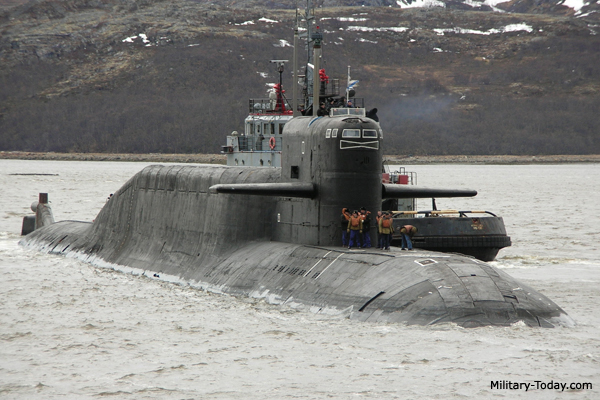Zarvan
ELITE MEMBER

- Joined
- Apr 28, 2011
- Messages
- 54,470
- Reaction score
- 87
- Country
- Location

The Delta IV class ballistic missile submarine is a further development of the Delta III class
Country of origin Soviet Union
Entered service 1985
Crew 135 men
Diving depth (operational) 300 m
Diving depth (maximum) 400 m
Sea endurance 90 days
Dimensions and displacement
Length 166 m
Beam 12.3 m
Draught 8.8 m
Surfaced displacement 13 500 tons
Submerged displacement 18 200 tons
Propulsion and speed
Surfaced speed 14 knots
Submerged speed 24 knots
Nuclear reactors 2 x pressurized water reactors
Steam turbines 2 x 44.7 MW
Diesel generators 2 x 1 074 hp
Auxiliary motors 1 x 1 007 hp
Armament
Missiles 16 x R-29RMU2.1 Layner nuclear ballistic missiles, SS-N-16 Stallion ASW missiles
Torpedoes 4 x 533 mm bow tubes for up to 18 torpedoes
Development of the Project 667 BDRM Delfin, known to NATO as the Delta IV class, began on 10 September 1975. The first boat, K-51 was commissioned into Northern fleet in December 1985. Between 1985 and 1990, seven Delta IVs were constructed by the Sevmashpredpriyatiye production association in Severodvinsk.
The Delta IV is a further modification of the Delta III, with an increased diameter pressure hull and a longer bow section. Displacement has increased by 1 200 tons and it is 12 m longer. These boats were constructed in parallel to theTyphoon class, in case the larger boats proved unsuccessful.
The Delta IV is a strategic platform, designed to strike military and industrial installations and naval bases. The submarine were originally fitted with R-29RM (Western designation SS-N-18 Skiff) missiles. This missile is referred by the START nuclear arms reduction treaty as the RSM-54. It is a three-stage liquid-propellant ballistic missile with a maximum range of 8 300 km. The warhead consists of 4 Multiple Independently Targeted Re-entry Vehicles (MIRVs), each rated at 200 kT, or 10 MIRVs, rated at 100 kT. The missile used Astro-inertial guidance and had a CEP of 550 m. Later the R-29RM missiles were replaced with improved R-29RMU2 Sineva. Currently these boats carry further improved R-29RMU2.1 Layner missiles.
All 16 ballistic missiles can be launched in a single salvo. Furthermore the Delta IV class submarines can launch their ballistic missiles from under the water while moving.
The submarine has four 533 mm torpedo tubes and can launch the Novator (SS-N-15 Starfish) anti-ship missiles or torpedoes. The Novator missile has a range of 45 km and is armed with a 200 kT nuclear warhead. Up to 18 missiles or torpedoes are carried on board.
The operational lifetime of these submarines was estimate to be 20-25 years, assuming normal maintenance schedules, but in the 1990s everything changed. When the START-1 treaty was signed in 1991, Russia was scheduled to dismantle one Yankee-class, five Typhoon-class and 25 assorted Delta class ballistic missile submarines by the year 2003. By September 1999, US specialists had helped disassemble one Yankee and six Deltas, while the Russians had destroyed another five ballistic missile subs on their own using US equipment. However none of the latest Delta IV class boats were destroyed.
As of 2000, the Russian Navy operated 5 Typhoon class submarines, 7 Delta IV class submarines, and 13 older Delta III class submarines, which between them carry 2 272 nuclear warheads on 440 ballistic missiles. With the chronic funding shortages affecting the Russian Navy many of these boats were of suspect seaworthiness. However, the Russian Navy reportedly believed that 12 operational nuclear ballistic missile submarines was the minimum necessary force structure for national security. It is likely that this force goal was maintained up until 2010 at least.
From 1999 a single Delta IV class submarine, the K-64, was converted to a special purpose boat. All of its missile silos were removed. After conversion in 2002 it was renamed the BS-64. It is now a mothership for mini submarines and used for underwater intelligence gathering. After protractive conversion it was relaunched in 2015.
Between 2002 and 2014 remaining 6 Delta IV class submarines were overhauled and upgraded in order to extend their service lives. Since around 2007 the boats were refitted with R-29RMU2 Sineva missiles. Since around 2014 the boats were once again refitted with further improved R-29RMU2.1 Layner missiles. These have a range of 8 300 km and can carry 12 low-yield warheads. This range is sufficient to strike targets in China, Europe and the United States.
By 2017 a total of 6 Delta IV class ballistic missile submarines remain in service with the Russian Navy. These operate in Northern and Pacific fleets and form a core of the Russian naval nuclear triad. It is planned that the Delta IV class submarines will remain operational until at least 2030. Currently a number of new Borei class ballistic missile submarines are being built in Russia. Once in service these will replace the ageing Delta III and Delta IV class boats.
Name Laid down Launched Commissioned Status
Verhoturye (K-51) 1981 1984 1985
active, in service
Ekaterinburg (K-84) 1982 1985 1985
active, in service
Podmoskovye (BS-64, ex K-64) 1982 1986 1986
converted to special purpose submarine. Active, in service
Tula (K-114) 1984 1987 1987
active, in service
Bryansk (K-117) 1985 1988 1988 active, in service
Karelia (K-18) 1986 1989 1989
active, in service
Novomoskovsk (K-407) 1987 1990 1990
active, in service
Delta IV Class
Ballistic Missile Submarine

Delta IV Class
Ballistic Missile Submarine

Delta IV Class
Ballistic Missile Submarine

Delta IV Class
Ballistic Missile Submarine

Delta IV Class
Ballistic Missile Submarine

Delta IV Class
Ballistic Missile Submarine

Delta IV Class
Ballistic Missile Submarine

Delta IV Class
Ballistic Missile Submarine










